Vegan Ramen
This vegan ramen is packed to the brim with vibrant flavors and hearty textures! It showcases a medley of fresh veggies bathed in a rich coconut milk broth. It offers the perfect blend of savory, spicy, and a hint of sweetness. Whether it’s a cozy evening meal or a special weekend lunch, vegan ramen bowls are sure to impress!

❤️ Why you’ll love this recipe
- The perfect balance of flavors: Each bite balances the umami of shiitake mushrooms, the richness of coconut milk, and the tang of lime.
- Highly customizable: You can throw in your favorite veggies or whatever you have on hand. Plus, you can garnish your bowls with so many different options!
- Vegan-friendly: Made with dairy-free milk and meat-free tofu crumbles, this recipe is perfect for those following a plant-based diet!
- Hearty: Vegan ramen serves as a comforting and satisfying meal at any time of the day or year.
If you love the idea of cooking delicious vegan meals like vegan ramen, you should really check out our other recipes like peanut noodles, vegan pad thai, teriyaki stir fry, and tofu buddha bowl.
🍜 What is vegan ramen?
Ramen originally comes from China, but it has since become a staple of Japanese cuisine, with each region having its own unique variation. While our vegan ramen is definitely not traditional, we’ve taken inspiration from these versions and infused it with Thai-inspired flavors.
It features tender ramen noodles served in a rich, savory broth infused with aromatics like ginger, garlic, and red curry paste. Shiitake mushrooms, baby bok choy, broccolini, and bell peppers bring texture and a burst of freshness.
Once everything comes together, it carries a balance of sweet, sour, creamy, spicy, and savory flavors. Serve it hot, garnished with a sprinkle of chopped peanuts, hot sauce, or sliced green onions for an added crunch.
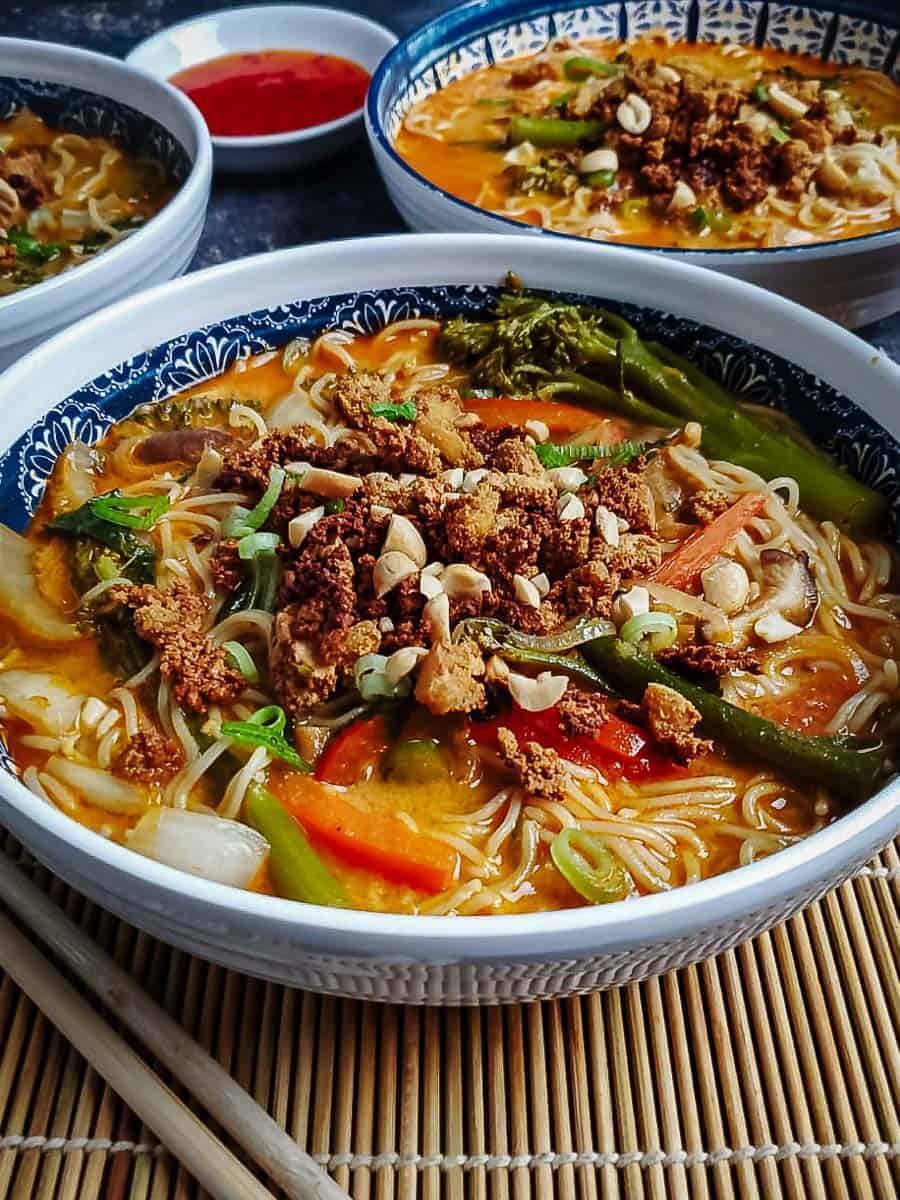
🌱 Is ramen vegan?
Unfortunately, traditional ramen is often not very vegan-friendly. In this recipe, we swapped out animal-derived ramen ingredients, like meat-based broth, cooked meat or seafood, and eggs, with plant-based alternatives without compromising on the taste. Here’s how we did it:
- Traditional broth → Vegetable broth and coconut milk: This vegan alternative gives the ramen its savory depth and creamy consistency.
- Meat toppings → Vegan ground beef: We use homemade vegan ground beef as a garnish, but you can use any of your favorite vegan proteins.
🤔 Types of ramen noodles
Navigating the world of ramen can be overwhelming, particularly when it comes to the variety of noodles used in this popular dish. Here are a few types you might come across:
- Hakata: Thin, straight noodles typically used in tonkotsu broth.
- Tokyo: Medium-thick, curly noodles often paired with soy-based broth.
- Sapporo: Thick, curly noodles perfect for miso-based broths.
- Tsukemen: Thick noodles that are served separately from the broth, which is used as a dipping sauce.
- Shirataki: Made from konjac yam, these are thin, translucent, and virtually calorie-free. They’re a good choice for those watching their carbohydrate intake.
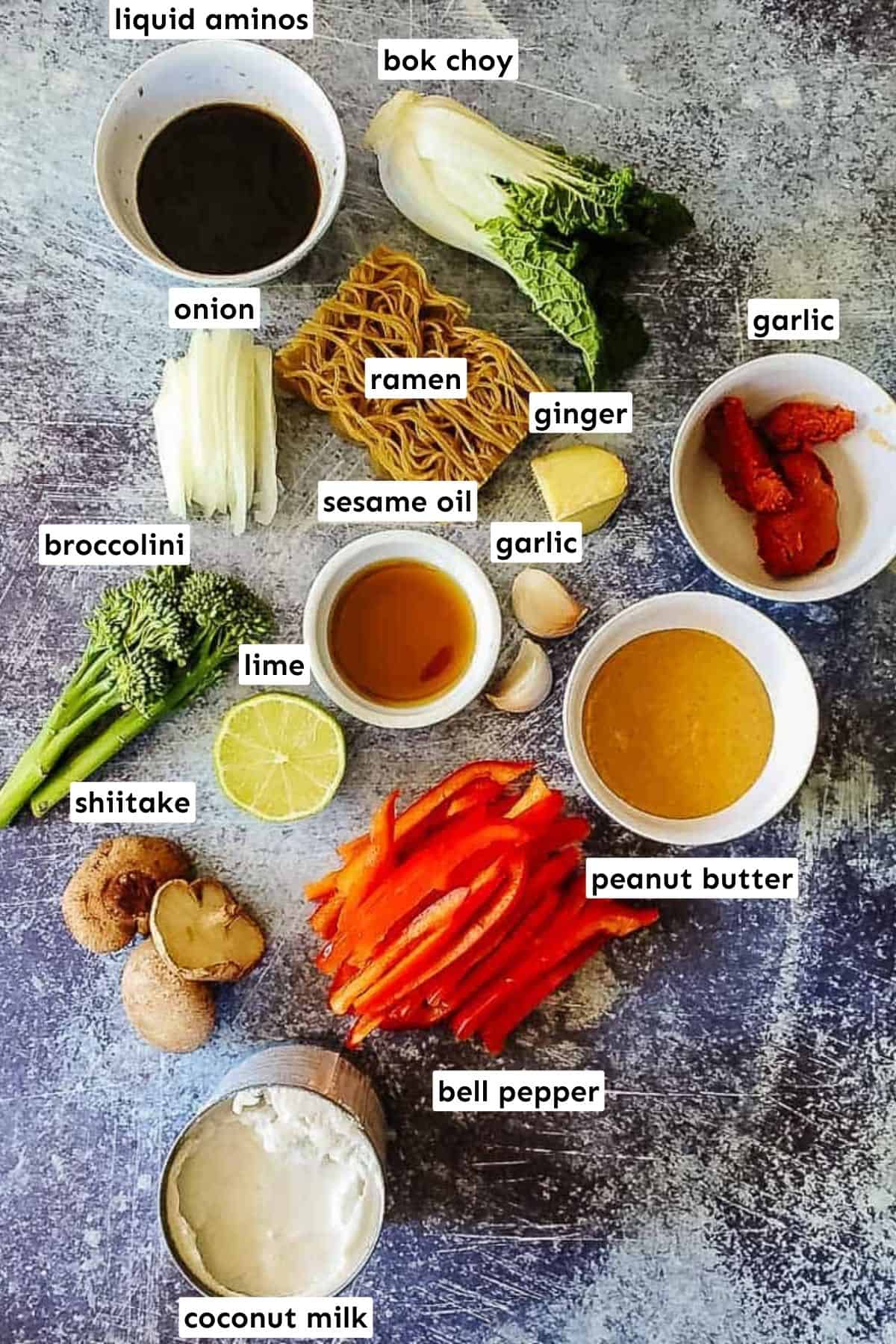
🛒 Ingredients & substitutions
- Ramen noodles: We use Lotus Foods millet & brown rice ramen since they’re naturally gluten-free and high in fiber, but you can definitely opt for fresh ramen noodles if you have access. You can also use rice noodles or glass noodles in place of ramen noodles.
- Sesame oil: Adds a distinct toasty flavor to the broth. Make sure it’s made with 100% sesame seeds for the best flavor. Or, use any vegetable oil if needed.
- Aromatics: We use white onion, garlic, and fresh ginger to form a savory, zesty, and slightly spicy aromatic base for the broth. You can also use yellow onions or shallots for a milder flavor.
- Vegetables: The blend of shiitake mushrooms, bell pepper, baby bok choy, and broccolini provides a hearty texture, savory depth of flavor, and a pop of color. Feel free to experiment with other veggies like carrots, corn, cabbage, leeks, bamboo shoots, and bean sprouts.
- Liquid aminos: This gives the broth its umami-rich flavor. If you don’t have liquid aminos, you can substitute it with tamari or soy sauce instead.
- Peanut butter: Adds a nutty richness to the broth. Make sure it’s natural peanut butter for the best taste and consistency. If you have a peanut allergy, try almond butter, tahini, or sunflower seed butter.
- Broth: We use vegetable broth and full-fat coconut milk to create a creamy and full-bodied base for the ramen. Either homemade or store-bought broth work.
- Thai red curry paste: Adds a tangy spice that balances the richness of the broth. If you can’t find red curry paste, try green curry paste or a mix of hot sauce and some extra garlic and ginger. Our go-to vegan-friendly Thai red curry paste is Mae Ploy, but just make sure yours doesn’t contain shrimp paste.
- Lime: Use freshly squeezed lime juice, not lime juice from concentrate, for the best flavor! If you don’t have any limes on hand, you can also use rice vinegar.
For a complete ingredient list and step-by-step guide, scroll down to our recipe card.
📝 How to make vegan ramen
Step 1: Create layers of flavor
Start by heating the sesame oil in a large soup pot. Add in the thinly sliced onion and shiitake mushrooms, sautéing until the onions become translucent.
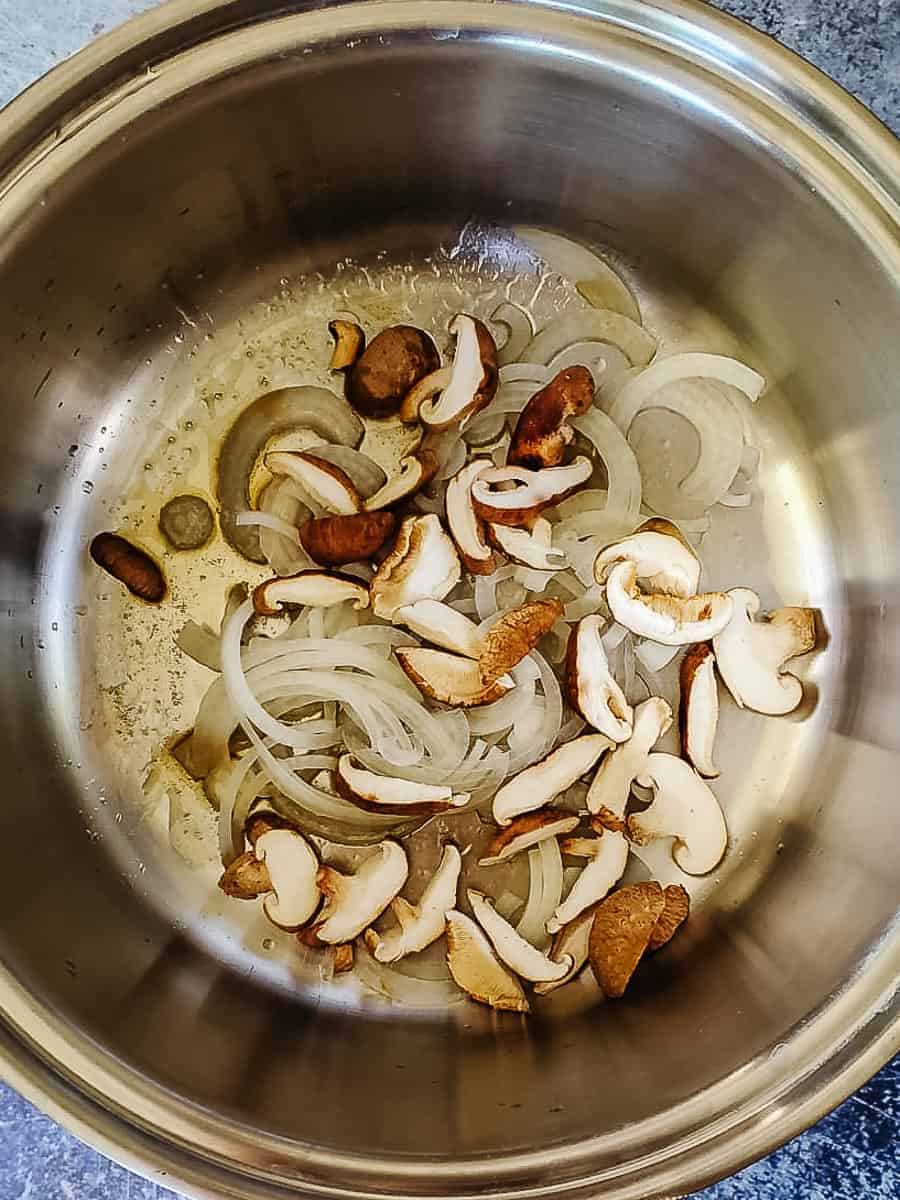

Next, toss in the minced garlic, ginger, bell peppers, red curry paste, peanut butter, and liquid aminos, stirring well to combine all the ingredients.
Step 2: Add the liquids
Pour in the vegetable broth, coconut milk, and lime juice. Give the broth a good stir, cover the pot, and reduce the heat to let it simmer and allow the flavors to meld together.


Step 3: Cook the noodles & broccolini
While the broth simmers, it’s time to prepare your ramen noodles! Boil them according to the package instructions, then drain and rinse them. At the same time, steam the broccolini in a separate pot until they are just tender.
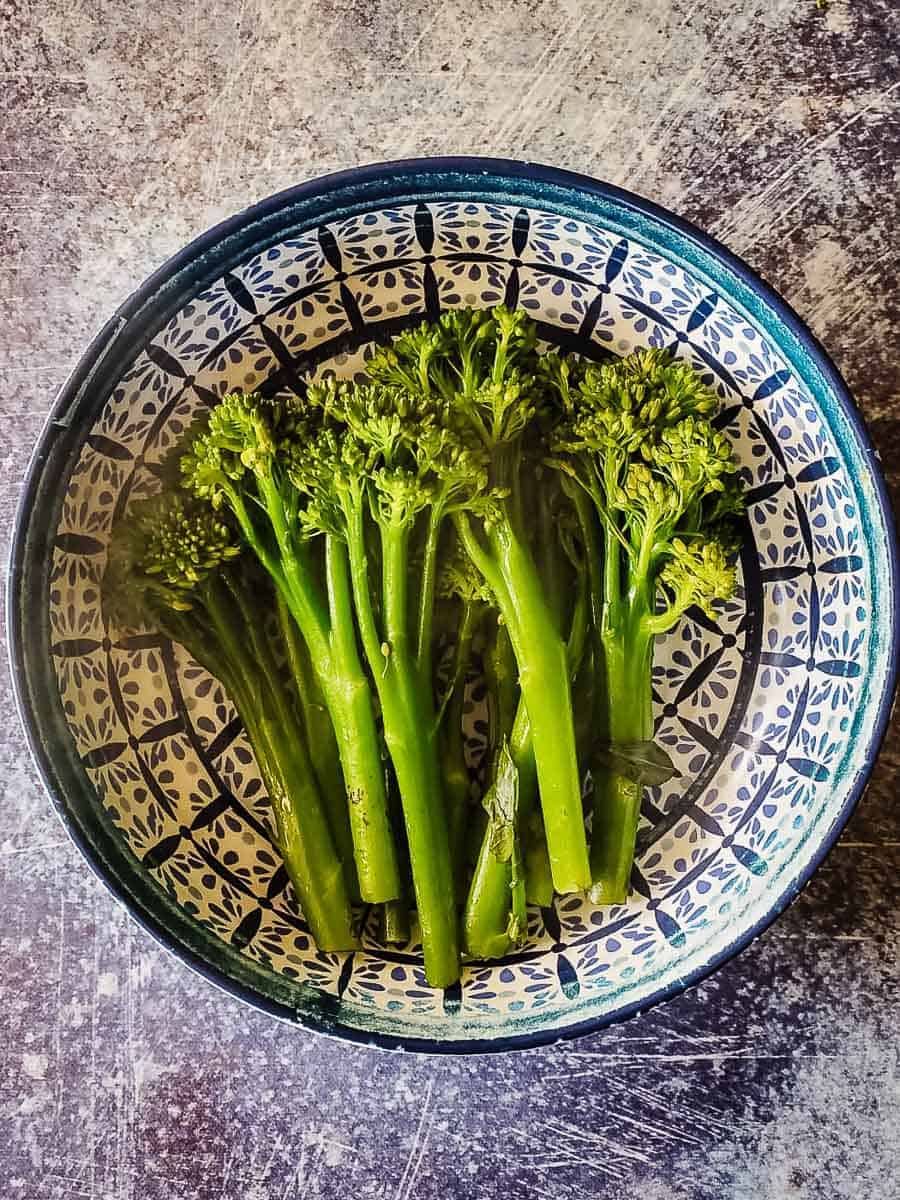
Step 4: Add the final touches
Just a few minutes before the broth is simmering, add the chopped baby bok choy. Once everything’s cooked, you can assemble your bowls. Divide the noodles evenly, ladle over the hot broth, and add your favorite garnishes. Happy eating!

If you have questions about this vegan ramen recipe, check out our FAQs or leave a comment down below!
🌶️ Garnishes for vegan ramen
This vegan ramen comes alive with garnishes! Make it your own by mixing and matching toppings like these:
- Protein: Add vegan ground beef or marinated tofu for a hearty, chewy element.
- Hot sauce: Our favorites are sambal oelek and Sriracha hot sauce.
- Chopped nuts: Use chopped peanuts or cashews for an additional crunch.
- Fresh herbs: Cilantro, Thai basil, or mint impart a herbaceous, aromatic touch.
- Green onions: Provides a pop of color and a mild onion flavor.
🌡️ Storage & reheating
Vegan ramen is best enjoyed fresh, but here are a few tips if you want to store it for later:
- Fridge: Store the broth, noodles, and toppings separately in airtight containers for up to 4-5 days in the refrigerator.
- Freezer: We only recommend freezing the broth. Store it in freezer-safe containers or glass jars. If kept this way, it can last up to 2 months.
- Reheating: Let the broth thaw in the fridge overnight, then reheat it on the stovetop until hot. If the noodles were stored in the fridge, a quick rinse under hot water can help loosen them up again.
- Prep ahead: You can prepare the broth and garnishes a day ahead and store it in the fridge. Cook the noodles just before serving.
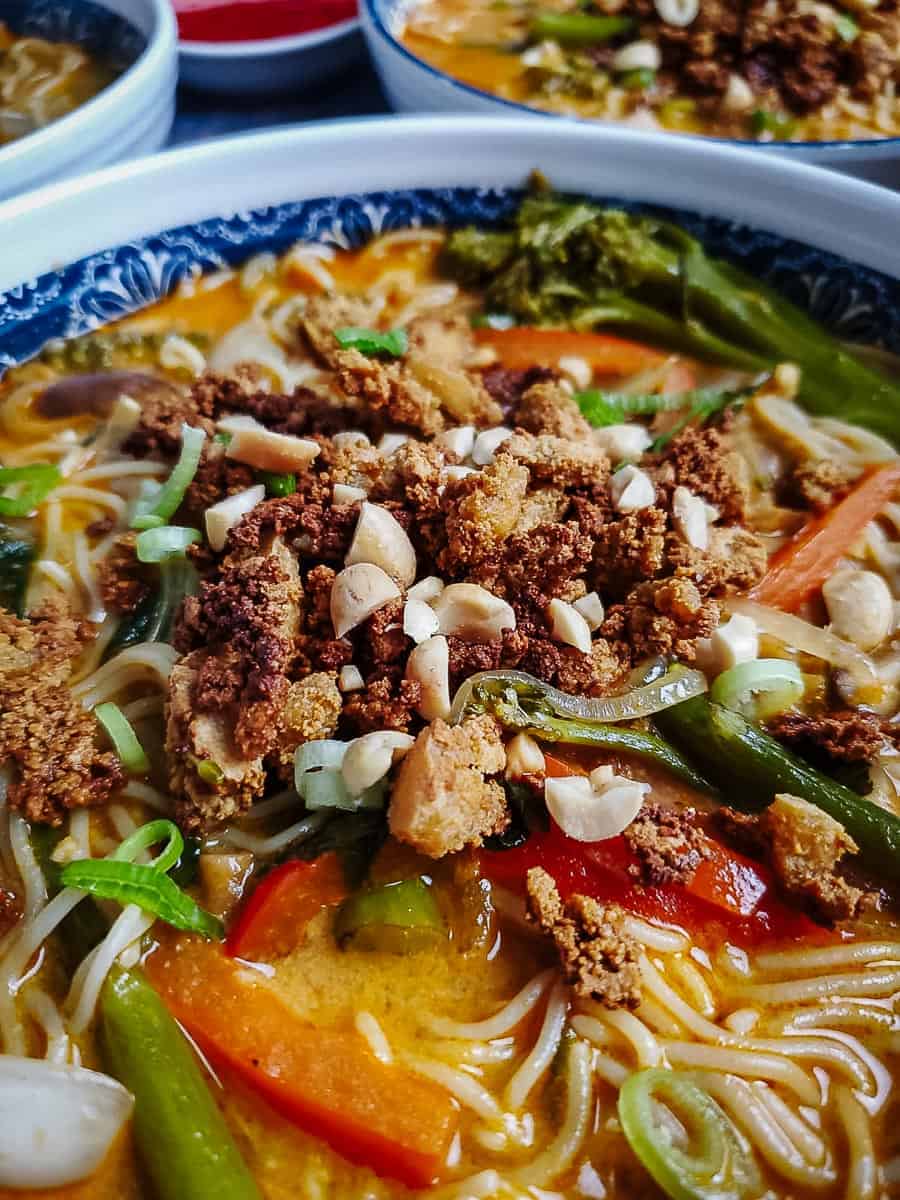
♻️ Variations
- Extra spicy: Amp up the spice by incorporating extra curry paste or freshly sliced red chiles in the broth as it simmers.
- Low carb: Use zoodles (zucchini noodles) or shirataki noodles instead of ramen noodles.
- Thai: Add a touch of lemongrass and kaffir lime leaves to the broth for even more Thai-inspired flavors.
- Greens: Incorporate some leafy greens, like kale or spinach, for a nutrient boost.
- Seafood style: Use homemade or store-bought vegan shrimp and nori.
🧑🍳 Top tips
- Don’t overcook the noodles: Cook the noodles just until al dente as they’ll continue to soften in the hot broth.
- Use fresh ingredients: Use fresh garlic and ginger for the best flavor. Fresh is always best when it comes to ramen!
- Don’t overcook the veggies: You want the vegetables to still have a slight bite so there is more texture in each bite.
- Full-fat coconut milk: Make sure to double-check that your can of coconut milk is full-fat. It will result in a much creamier, richer broth.
- Wait for the toppings: Add the toppings just before serving to keep them fresh and crunchy.
- Adjust the spice: Customize the heat according to your preference by adding or reducing the amount of curry paste in the broth.
- Use natural butter: It adds a much better flavor and texture than creamy peanut butter.
💬 FAQ
This vegan ramen recipe uses millet and brown rice noodles and liquid aminos, making it gluten-free. However, if you use traditional ramen noodles or soy sauce, it will not be gluten-free. Always double-check your individual ingredients.
If you don’t like coconut milk, you can use any other non-dairy milk like almond, soy, or cashew milk. Just keep in mind that it will change the texture and flavor of the dish.
You can definitely use instant ramen noodles for this vegan ramen recipe. Just realize that they won’t provide quite the same taste or texture as other noodle varieties.
🍴 More noodle recipes
If you loved this vegan ramen recipe, you might also enjoy these vegan noodle and pasta recipes:
- Sopa de Fideo: Comforting soup made from toasted pasta and tomato broth.
- Espagueti Verde: Mexican green spaghetti with a light spice.
- Lemon Garlic Pasta: A simple spaghetti recipe with a light, zesty sauce.
- Espagueti Blanco: A creamy twist on a classic dish popularized in Mexico.
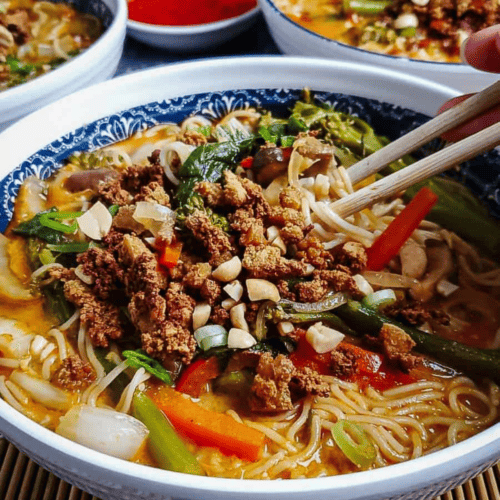
Best Vegan Ramen
Equipment
- Large pot
- Chef's knife
- Steamer
- Strainer
Ingredients
- 1 tablespoon sesame oil
- ¼ medium white onion, thinly sliced
- 8 whole shiitake mushrooms
- 2 cloves garlic, minced
- 2 tablespoons fresh ginger, minced
- 1 whole bell pepper, julienned
- ¼ cup smooth peanut butter
- ¼ cup Thai red curry paste
- 3 tablespoons liquid aminos
- 4 cups vegetable broth
- 1 ¾ cups full-fat coconut milk
- 2 tablespoons lime juice
- 8 stalks broccolini
- 2 cups baby bok choy, roughly chopped
- Sea salt & pepper to taste
Noodles
- 4 ramen cakes
Garnishes
- Vegan ground beef
- Sambal oelek paste
- Sriracha hot sauce
- Chopped peanuts
- Chopped cilantro
- Sliced green onions
Instructions
- Heat the sesame oil in a large stockpot over medium. Add the onion and mushrooms. Sauté for 2-3 minutes, or until onions are turning translucent.
- Add minced garlic, ginger, red bell peppers, red curry paste, peanut butter, and liquid aminos. Stir the mixture until combined.
- Pour in the vegetable broth, coconut milk, and lime juice. Stir again, then cover the pot and reduce heat to simmer for ~10 minutes.
- In the meantime, wash and steam the broccolini in a steamer pot or a pot with a basket insert. Once softened, set aside for serving.
- Bring another pot of water to a boil. Mix in the ramen cakes, and cook according to package directions, or until they're al dente. Drain and rinse the noodles.
- With about 2-3 minutes left of simmering, add the chopped baby bok choy to the broth. Taste and adjust the seasonings as needed.
- To assemble, divide the noodles evenly between bowls. Ladle broth over top and add a couple of stalks of broccolini.
- Garnish the bowls with vegan ground beef, hot sauce, chopped peanuts, or sliced green onions. Happy eating!
Notes
- Don’t overcook the noodles: Cook the noodles just until al dente as they’ll continue to soften in the hot broth.
- Use fresh ingredients: Use fresh garlic and ginger for the best flavor. Fresh is always best when it comes to ramen!
- Don’t overcook the veggies: You want the vegetables to still have a slight bite so there is more texture in each bite.
- Full-fat coconut milk: Make sure to double-check that your can of coconut milk is full-fat. It will result in a much creamier, richer broth.
- Wait for the toppings: Add the toppings just before serving to keep them fresh and crunchy.
- Adjust the spice: Customize the heat according to your preference by adding or reducing the amount of curry paste in the broth.
- Use natural butter: It adds a much better flavor and texture than creamy peanut butter.
- Nutritional information is a rough estimate and should not be taken as health advice.
Nutrition
Note: We’ve updated this post to include new information and helpful tips about the recipe.
Justine Drosdovech is a food writer, photographer, and one of the founders of Broke Bank Vegan. She is a self-taught plant-based chef but uses her healthcare background to craft dishes that are both delicious and nourishing.

Definitely delicious. It is a very easy, creatively fun soup to create before your very eyes 👀 and 👃. Those spices, combined with the peanut butter and coconut milk. My, my, my
Nutritious too.
Thank you so much for your recipe
Hey William!
Thanks so much for the kind words! It’s definitely a fun soup to make. We’re glad you enjoyed it!